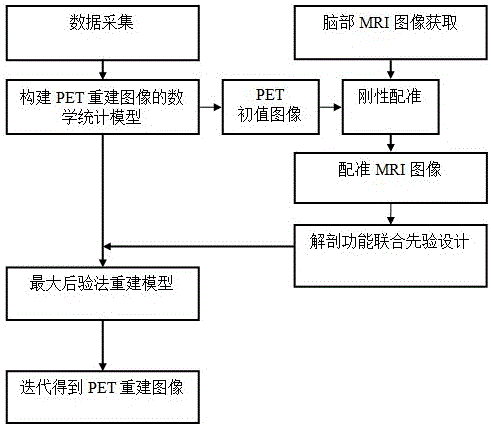Maximum a posteriori reconstruction method for pet images based on joint prior model of anatomical function
A combined prior and maximum a posteriori technique, applied in the field of PET image processing of medical images, can solve problems such as affecting the quality of reconstructed images, large noise errors in segmentation or edge extraction, etc.
- Summary
- Abstract
- Description
- Claims
- Application Information
AI Technical Summary
Problems solved by technology
Method used
Image
Examples
Embodiment 1
[0052] A method for maximum posterior reconstruction of PET images based on anatomical function combined prior models includes the following steps in sequence.
[0053] (1) Acquire PET data for reconstruction through imaging equipment.
[0054] Specifically, the detection data before PET imaging is collected by the imaging device, and the correction parameter values and the system matrix of the imaging device are obtained at the same time, and the acquired detection data is corrected by the imaging device to obtain the corrected detection data, and the corrected detection data is obtained. The detection data is used as PET data for reconstruction. In the art, the detection data is also called projection data, and the corrected detection data or projection data is the PET data used for reconstruction.
[0055] (2) According to the statistical characteristics of the PET data obtained in step (1), construct a mathematical statistical model for reconstructing the image. PET data Mee...
Embodiment 2
[0084] Taking the brain image of the phantom shown in Fig. 2 as an example, a method for maximum posterior reconstruction of a PET image based on an anatomical function combined prior model of the present invention will be described. figure 1 As shown, the following steps are included.
[0085] (1) Acquire PET data for reconstruction through imaging equipment.
[0086] The detection data before PET imaging is collected by the imaging device, and various data correction parameter values in the imaging device and the system matrix of the imaging device are obtained at the same time. In this embodiment, the data acquisition method is full three-dimensional acquisition; the system matrix P corresponds to the parallel belt-shaped geometric model. Specifically, the collected data is stored in the array first, and the system obtains the scan time calibration coefficient, the detector efficiency, the attenuation coefficient and the time correction coefficient, and all the detected random...
PUM
 Login to View More
Login to View More Abstract
Description
Claims
Application Information
 Login to View More
Login to View More - R&D
- Intellectual Property
- Life Sciences
- Materials
- Tech Scout
- Unparalleled Data Quality
- Higher Quality Content
- 60% Fewer Hallucinations
Browse by: Latest US Patents, China's latest patents, Technical Efficacy Thesaurus, Application Domain, Technology Topic, Popular Technical Reports.
© 2025 PatSnap. All rights reserved.Legal|Privacy policy|Modern Slavery Act Transparency Statement|Sitemap|About US| Contact US: help@patsnap.com



